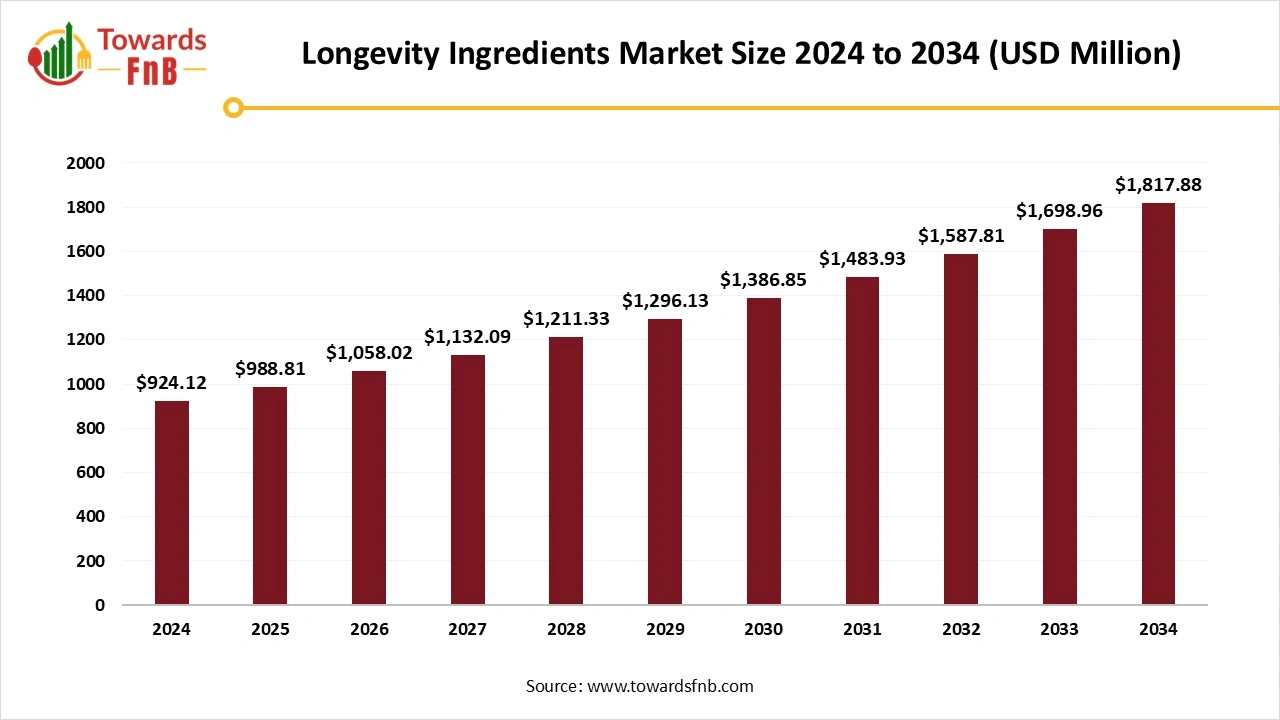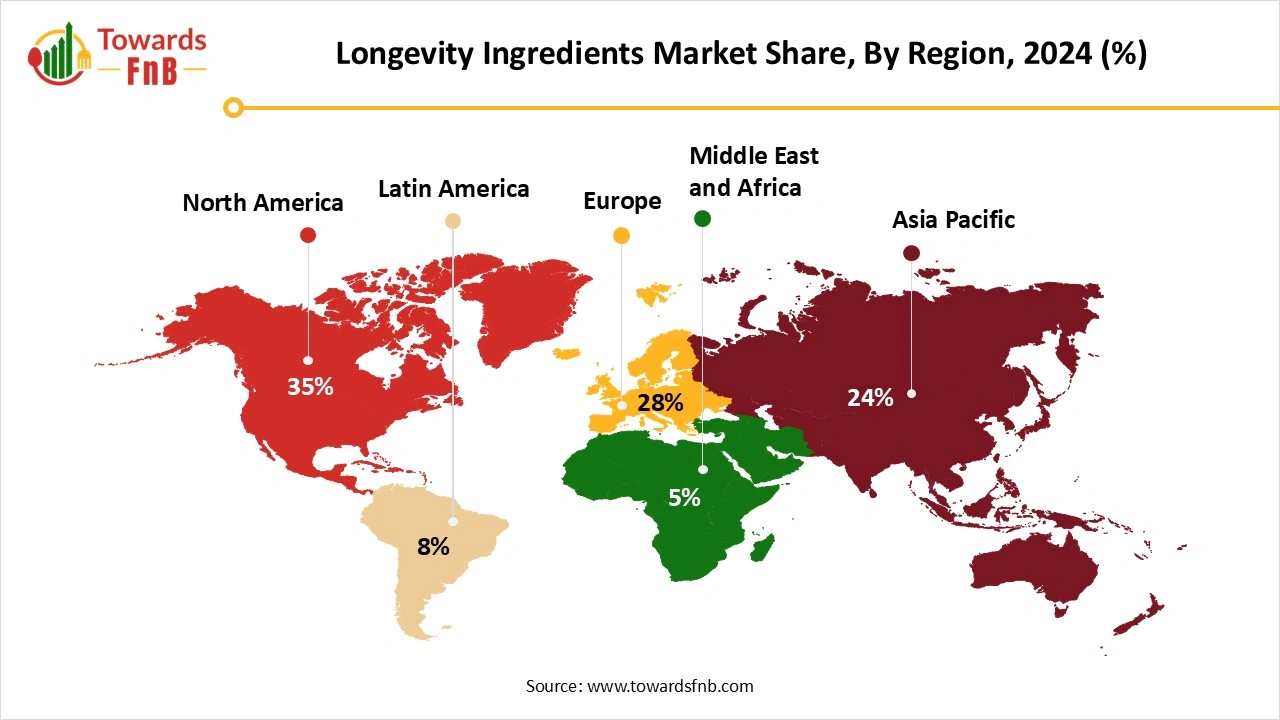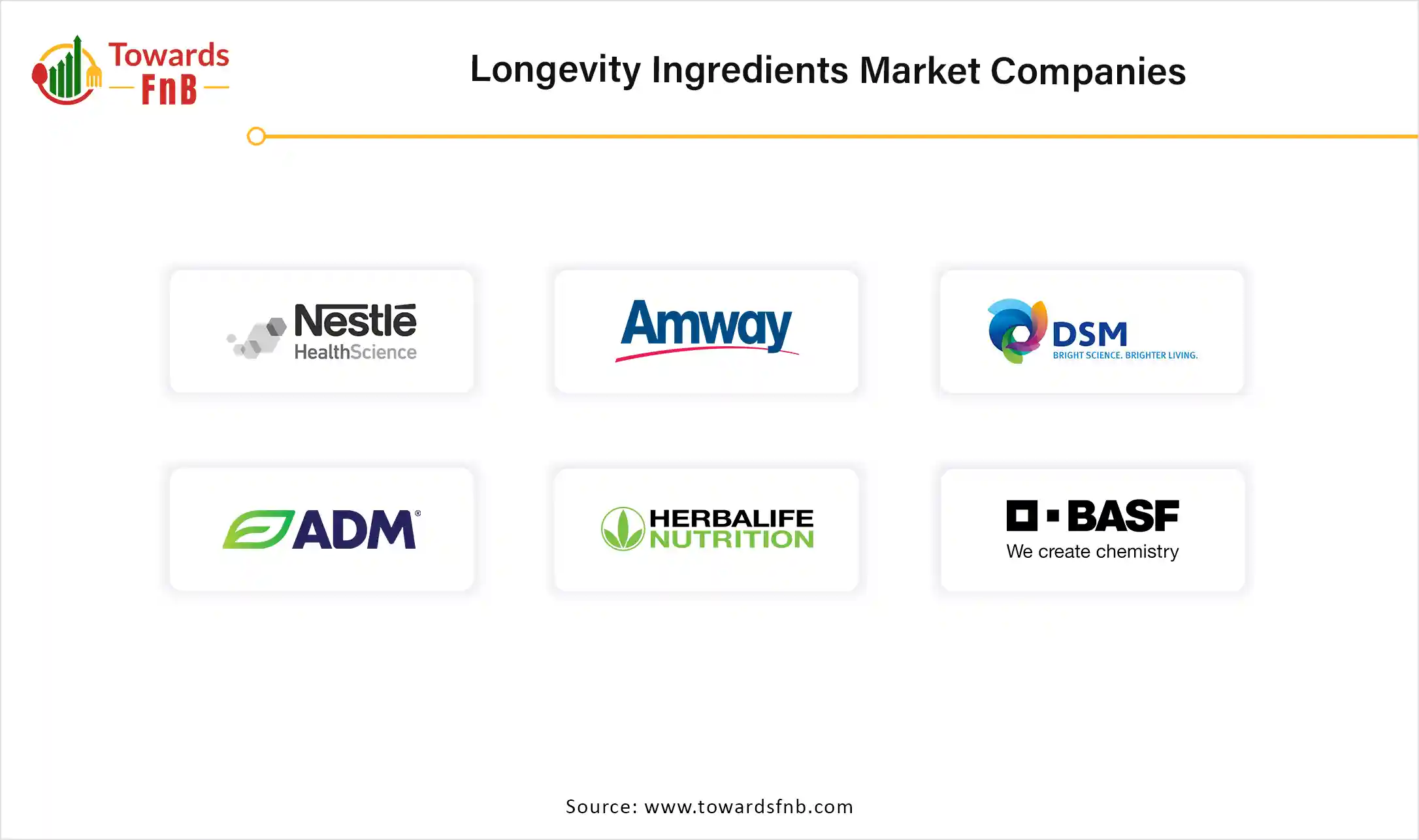December 2025
The global longevity ingredients market size was estimated at USD 924.12 million in 2024 and is expected to rise from USD 988.81 million in 2025 to nearly reaching USD 1,817.88 million by 2034, growing at a CAGR of 7% during the forecast period from 2025 to 2034. These bioactive compounds, derived from natural and functional sources, are being incorporated into supplements, beverages, and functional foods to promote healthy aging and disease prevention.

The longevity ingredients market refers to the market for various bioactive compounds, extracts, and nutrients designed to enhance lifespan, improve overall health, and slow the aging process. These ingredients are typically used in food, beverages, supplements, and cosmetics and focus on cellular health, age-related diseases, and rejuvenation of bodily functions. They include substances such as antioxidants, vitamins, minerals, polyphenols, amino acids, and probiotics, which are believed to influence biological processes linked to aging.
The market is evolving from niche anti-aging supplements to a full-fledged functional nutrition sector. Increasing awareness around cellular health, cognitive function, and metabolic balance is fueling demand across all age groups, not just the elderly. Ingredients like NMN, resveratrol, astaxanthin, and adaptogens are now being integrated into daily wellness routines. Cross-industry collaboration between biotech firms, supplement brands, and nutraceutical companies is accelerating innovation. Consumers are increasingly seeking science-backed, natural solutions that go beyond beauty to target aging at the root level. As the line between food and medicine continues to blur, the longevity market is poised for exponential growth.
One of the key market drivers is the global shift from disease treatment to prevention, with consumers taking proactive steps to enhance their health span. The rising incidence of lifestyle-related diseases has pushed people to explore natural, science-backed compounds that improve immunity, energy, cognitive health, and cellular repair. The ageing global population, particularly in Asia and Europe, is actively seeking non-pharmacological interventions for age-related decline. Influencer-driven health trends and access to educational content have also boosted awareness of ingredients like collagen and NDA boosters. With chronic inflammation now recognized as a major contributor to aging, anti-inflammatory botanicals are in high demand. The growing trust in nutraceuticals as a daily health ally is further fueling sustained demand for longevity-focused ingredients.
Significant opportunities lie in expanding longevity ingredients into personalized wellness and mainstream food categories. Startups and established brands alike can capitalize on the demand for functional beverages, protein bar, and daily nutrition packs infused with age-supportive compounds. Emerging market in certain regional parts presents immense potential due to rising disposable incomes and growing awareness of healthy aging. Innovations in ingredients extraction and bioavailability are opening doors to reintroduce traditional herbs like ashwagandha and ginseng with enhanced efficacy. There’s also a growing market for gender specific and hormonal health longevity products, especially for women over 40. Moreover, the integration of AI, wearables and biomarkers into consumer products could soon bring fully personalized longevity nutrition to the mass market.
Despite its promise, the longevity ingredients market faces significant restraints. Scientific validation remains a critical bottleneck, as many claims around anti-aging effects lack robust clinical evidence. Regulatory scrutiny is tightening across regions, especially where functional foods make therapeutic claims. High production and R&D costs, especially for advanced compounds like NMN or synthetic resveratrol, can deter small players. Consumer skepticism toward exaggerated marketing claims also affects brand credibility and trust. Additionally, variability in adsorption and effectiveness across individuals presents formulation challenges. Without proper standardization and education, the market risks being perceived as hype rather than health science.
Why Is North America Leading The Longevity Revolution?
North America dominated the market in 2024, driven by its advanced healthcare infrastructure and widespread awareness of preventive nutrition. The region is home to a mature nutraceutical industry, where longevity-focused products are increasingly backed by clinical research and consumer trust. High per capita health spending and access to personalized wellness technologies are supporting growth in both dietary supplements and functional food applications. Consumers across the U.S. and Canada are actively seeking natural, science-backed solutions for aging-related concerns like inflammation, cognitive decline, and cellular fatigue. Longevity ingredients such as NMN, resveratrol, and adaptogenic herbs are experiencing strong retail traction. Additionally, regulatory clarity around supplement labeling and functional claims has fostered confidence in the market.
The U.S. represents the dominance in North America; A strong digital health ecosystem is also allowing for the growth of AI-driven personalization in longevity nutrition. The aging Baby Boomer population remains a key target group, but millennials and Gen Z are increasingly adopting preventive strategies to extend their health span. Clean-label trends and transparency expectations are pushing brands to invest in plant-based, traceable, and clinically supported ingredients. Direct-to-consumer wellness platforms are thriving, further fueling market visibility and access. As science and lifestyle intersect, North America is likely to remain the epicenter of longevity ingredient innovation.

Why is Asia-Pacific the Fastest-Growing Longevity Ingredients Market?
Asia Pacific expects the fastest growing in the market in 2024, Countries such as Japan, China, South Korea, and India are experiencing a sharp increase in demand for age-supportive nutrition. Traditional medicine systems like Ayurveda and Traditional Chinese Medicine (TCM) are merging with modern science to create a unique base for longevity-focused innovations. Consumers are embracing preventive health habits, with a strong focus on immune strength, energy, and joint health. Growing urbanization, improved healthcare access, and awareness of functional foods are further driving the uptake of longevity ingredients. The region’s diverse consumer base is open to both traditional botanicals and cutting-edge bioactive compounds.
India is emerging as the key player in the Asia Pacific, and plant-based and adaptogenic ingredients such as ashwagandha, ginseng, and turmeric are already culturally accepted, creating a favorable entry point for longevity formulations. Governments are promoting healthy aging initiatives, increasing demand for functional ingredients in mass-market and clinical nutrition. Multinational brands are partnering with regional players to co-develop localized, culturally relevant products. E-commerce platforms are proving to be a strong growth channel for nutraceuticals, particularly among tech-savvy younger demographics. Bioavailability-enhancing formats like sachets, powders, and ready-to-drink elixirs are gaining momentum. With a perfect blend of ancient health philosophies and modern lifestyle needs, Asia Pacific is positioned to redefine the global longevity nutrition narrative.
Why are Antioxidants Dominating the Longevity Ingredients Market?
The antioxidants segment dominated the longevity ingredients market in 2024, due to their foundational role in combating oxidative stress, a key factor in aging. These compounds neutralize free radicals that damage cells, making them central to anti-aging and disease-prevention strategies. Popular antioxidants like resveratrol, astaxanthin, and vitamin C are widely incorporated into dietary supplements and skincare-linked functional foods. Scientific backing and long-term consumer familiarity have made antioxidant ingredients both trusted and market-proven. Additionally, their broad applications across cognitive health, skin vitality, and cardiovascular function enhance their commercial appeal. With preventive wellness on the rise, antioxidants remain the go-to solution for those seeking holistic, age-supportive nutrition.
The ingredient’s versatility allows it to be formulated across capsules, beverages, powders, and even beauty-from-within formats. Manufacturers continue to innovate around bioavailability-enhancing formats such as liposomal delivery and nano-encapsulation. As consumer awareness of oxidative damage increases, demand for high-potency, standardized antioxidant blends is growing. Functional claims like anti-fatigue, cellular protection, and immune boost are further amplifying market traction. Regulatory support for established antioxidants also facilitates easier product approvals and wider geographic expansion. As longevity grows, antioxidants will continue to anchor the segment as its most widely adopted and trusted ingredient class.
The Amino Acids Segment Expects the Fastest Growth in the Longevity Ingredients Market During the Forecast Period.
Due to their multifaceted role in muscle repair, metabolism, and mitochondrial health. As people aim to maintain strength and vitality with age, amino acids like leucine, glutamine, and taurine are increasingly sought after. These ingredients support protein synthesis, reduce muscle degradation, and aid recovery, especially important for aging populations and active older adults. They also contribute to hormonal regulation, neurotransmitter balance, and cardiovascular support. Longevity brands are using amino acids in formulations for strength, mobility, cognitive performance, and stress resilience. Their adaptability across age demographics is driving rapid adoption.
Advancements in amino acid profiling and personalized supplementation have made these compounds central to precision longevity nutrition. Clinical trials exploring branched-chain and essential amino acids for sarcopenia and metabolic disorders are generating strong interest. Amino acids are now found in everything from functional beverages to sleep support blends. Vegan and fermented sources of amino acids are gaining popularity, aligning with clean-label and plant-forward trends. Their rapid absorption and synergy with other nutrients like vitamins and minerals enhance their therapeutic effect. As functional fitness becomes an aging strategy, amino acids are poised to become the new heroes of healthy aging.
How Dietary Supplements Is Dominating The Longevity Ingredients Market?
The dietary supplements segment dominated the market in 2024, Consumers prefer supplements for their convenience, potency, and targeted formulation benefits. Longevity supplements typically feature a combination of antioxidants, anti-inflammatories, and adaptogens aimed at cellular support and disease prevention. Capsules, gummies, tablets, and soft gels remain top delivery formats, allowing for precise dosing and easy integration into daily routines. The growing popularity of personalized packs and subscription models is making longevity supplementation more accessible and customized. Trust in science-backed formulas and clinical validation is further supporting strong growth in this segment.
Branding around age gracefully, health span, and inner vitality is resonating deeply with middle-aged and senior demographics. Supplements are also bridging the wellness gap for younger generations, especially those interested in biohacking and preventive health. Rapid innovation around delivery systems like time-release and liposomal formats boosts absorption and appeal. Retailers and D2C platforms are offering bundles that combine longevity-focused SKUs with broader wellness goals such as sleep, immunity, and cognition. Global expansion is supported by well-established regulatory frameworks for nutraceuticals and supplements. As the first line of defense against aging, dietary supplements will continue to dominate the market landscape.
The functional foods segment expects the fastest growth in the longevity ingredients market during the forecast period.
Propelled by the demand for convenience, daily nutrition, and clean-label wellness. Consumers are seeking to incorporate health-supportive ingredients directly into their diets without the need for separate supplements. Longevity-focused formulations are appearing in cereals, protein bars, beverages, and dairy alternatives, bringing age-supportive nutrition into everyday routines. This shift is particularly strong among millennials and Gen Z, who prefer food-based health solutions over pills. Claims like “anti-aging, cell renewal, and support for active aging are driving innovation in product development. Functional foods also offer greater flexibility for personalization and sensory appeal.
The line between food and medicine is blurring, with ingredients like collagen, omega-3s, and nootropics making their way into snackable and drinkable formats. Brands are developing product lines that blend indulgence with longevity, like anti-aging chocolates and adaptogen-infused teas. The rise of personalized wellness apps and smart nutrition tracking is fueling interest in foods with measurable, functional benefits. As regulatory acceptance for health claims improves globally, functional longevity products are gaining shelf space and visibility. Fortified foods are especially popular in emerging markets where supplement penetration is low. With lifestyle integration becoming a top priority, functional foods represent a key growth frontier for longevity nutrition.
How Plant-Based Is Leading The League?
The plant-based supplements segment dominated the longevity ingredients market in 2024, Consumers associate plant-derived ingredients with safety, sustainability, and natural healing traditions. Ingredients such as curcumin, green tea extract, polyphenols, and resveratrol are not only well-researched but also culturally embedded in global health practices. The plant-based trend aligns with the broader shift toward clean-label, vegan, and eco-conscious nutrition. These ingredients often offer multiple health benefits, including antioxidant, anti-inflammatory, and adaptogenic, making them ideal for multifunctional longevity formulas. As consumer skepticism toward synthetic or heavily processed additives grows, plant-based ingredients enjoy strong credibility and trust.
Many longevity brands are highlighting their use of sustainably sourced botanicals and traditional herbs, appealing to both ethics and efficacy. Innovations in plant extraction and fermentation are enhancing potency and consistency across formulations. The plant-based sector is also benefiting from the widespread availability and affordability of raw materials. Health-conscious consumers are willing to pay a premium for green longevity, especially in premium supplements and functional foods. Transparency in sourcing and organic certification further strengthens consumer confidence. As longevity moves mainstream, plant-based options will remain the default choice for clean, holistic aging support.
The animal-based segment is expected to experience the fastest growth in the longevity ingredients market during the forecast period.
Due to its high bioavailability and proven efficacy. Ingredients like marine collagen, omega-3 fatty acids, and gelatin-derived peptides are widely acknowledged for their benefits in skin health, joint support, and inflammation reduction. These ingredients offer complete amino acid profiles and faster absorption, making them particularly effective in aging-related applications. Their appeal is strong among aging consumers looking for results in bone density, skin elasticity, and muscle maintenance. Clinical evidence supporting animal-based ingredients is also increasing their credibility in therapeutic formulations. The demand for high-impact, results-driven longevity products is pushing these ingredients into the spotlight.
Technological improvements have made it possible to produce cleaner, ethically sourced, and even flavor-neutral animal-derived ingredients. Marine collagen from fish skin and bones is gaining popularity for its sustainability and traceability. While not always aligned with vegan trends, these ingredients offer unique structural benefits that plant-based options often lack. Premium longevity brands are launching targeted SKUs that combine both plant and animal-derived compounds for holistic support. Animal-based ingredients are also prominent in the beauty-from-within category, where efficacy is a key driver. With scientific backing and rising consumer demand, this segment is rapidly expanding its footprint in the longevity space.
Why Is Antioxidant Defense Dominating The Longevity Ingredients Market?
The antioxidant defense segment dominated the market in 2024, Free radical damage is linked to DNA degradation, inflammation, and cellular breakdown all of which contribute to aging. Ingredients that support antioxidant defenses like astaxanthin, quercetin, and glutathione, are widely used in both preventive and therapeutic applications. These compounds protect cells from internal and environmental stressors, preserving function and extending vitality. The appeal of this mechanism lies in its universality; it addresses a core aging trigger across all systems. Formulations with antioxidant defense claims are resonating across age groups and product formats.
Antioxidant-rich ingredients are often formulated with complementary compounds like vitamins E and C to enhance the effect. Products targeting immune health, brain function, and skin aging commonly highlight antioxidant protection. Innovations in delivery systems have improved the bioavailability and stability of antioxidant compounds. This mechanism is especially powerful in combination formulas where multiple pathways of aging are addressed. Consumer awareness of oxidative damage and its impact on appearance, performance, and longevity is growing rapidly. As a foundational health concept, antioxidant
The cellular Regeneration segment is expected to experience the fastest growth in the longevity ingredients market during the forecast period.
This mechanism focuses on repairing, restoring, and renewing cells to extend their functional lifespan. Ingredients like NMN, NAD+ precursors, peptides, and stem cell activators are gaining attention for their role in supporting mitochondrial health and cell turnover. The idea of "biological rejuvenation" is especially attractive to proactive wellness consumers seeking to delay degenerative changes. Longevity brands are formulating products aimed at energy production, DNA repair, and stem cell support. The science of cell regeneration aligns closely with the biohacking and anti-aging medicine movement.
Gotvoom Inc

By Type of Ingredients
By Application
By Source
By Mechanism of Action
By Region
December 2025
December 2025
December 2025
December 2025